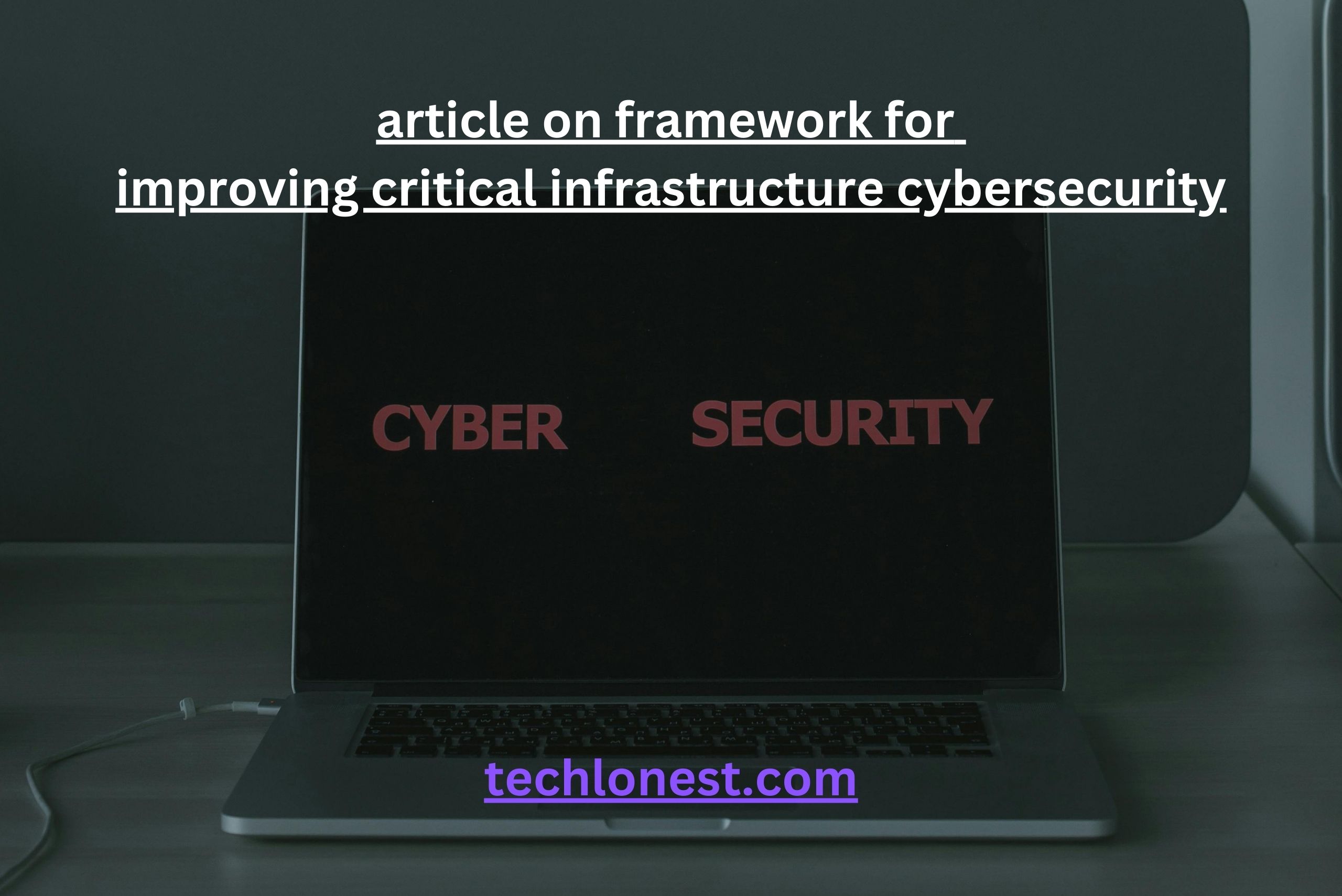In our cutting-edge, interconnected society, the security of essential infrastructure is more crucial than ever. From electricity grids and water deliver structures to transportation networks and healthcare centers, these essential offerings form the spine of our day by day lives. However, as era evolves, so do the threats focused on these vital structures. This Article on Framework for Improving Critical Infrastructure Cybersecurity offers a complete guide to safeguarding those indispensable offerings towards cyber threats, making sure their resilience and reliability.
Understanding Critical Infrastructure Cybersecurity
Imagine waking as much as a town-extensive power outage because of a cyberattack. Hospitals lose access to patient information, site visitors indicators malfunction, and conversation networks fail. This situation, although alarming, highlights the essential significance of sturdy cybersecurity measures for important infrastructure.
Critical infrastructure encompasses the assets, systems, and networks important for the functioning of society and the economy. Protecting those structures from cyber threats is important to hold public protection, financial stability, and national safety.
Why Article on Framework for Improving Critical Infrastructure Cybersecurity?
Critical infrastructure systems are increasingly dependent on digital technologies, making them prone to cyberattacks. A a hit breach can lead to severe results, inclusive of:
- Disruption of Essential Services: Interruptions in power, water, or transportation can have instant and full-size impacts.
- Economic Losses: Downtime and recovery costs may be large, affecting agencies and purchasers alike.
- Safety Risks: Compromised systems can endanger lives, especially in sectors like healthcare and emergency services.
- National Security Threats: Cyberattacks on vital infrastructure can undermine countrywide protection and public accept as true with.
A Step-via-Step Guide to Enhancing Cybersecurity

Improving cybersecurity for crucial infrastructure includes a scientific technique. Below is a step-by-step guide to assist organizations in bolstering their defenses.
1. Conduct a Comprehensive Risk Assessment
Risk evaluation is the foundation of any effective cybersecurity approach. It involves identifying ability threats, vulnerabilities, and the effects of various cyber incidents.
- Identify Assets: Catalog all-important property, which includes hardware, software, records, and personnel.
- Analyze Threats: Determine potential threats, consisting of malware, ransomware, insider threats, and country-backed attacks.
- Evaluate Vulnerabilities: Assess weaknesses that would be exploited in your structures.
- Determine Impact: Understand the outcomes of different cyber incidents and their effects on your operations.
Example Anecdote: In 2015, a cyberattack on Ukraine’s electricity grid brought on vast outages. A thorough danger assessment should have diagnosed vulnerabilities inside the gadget, doubtlessly preventing the assault.
2. Develop and Implement Security Policies
Establishing clear protection regulations affords suggestions for protective important infrastructure. These policies ought to cowl areas along with:
- Access Control: Define who has access to sensitive systems and statistics.
- Data Protection: Implement measures to safeguard information integrity and confidentiality.
- Incident Response: Outline methods for responding to cyber incidents.
- Compliance: Ensure adherence to relevant laws, rules, and requirements.
Security Policy Best Practices
3. Deploy Advanced Security Technologies
Leveraging the right protection technologies is important for protecting towards cyber threats. Key technologies encompass:
- Firewalls and Intrusion Detection Systems (IDS): Monitor and control incoming and outgoing community visitors.
- Encryption: Protect sensitive records both in transit and at relaxation.
- Multi-Factor Authentication (MFA): Add an extra layer of security for person access.
- Endpoint Protection: Secure devices connected to the community from malware and other threats.
Example Anecdote: A health center implemented MFA for all access points, stopping unauthorized access even when employee credentials had been compromised.
4. Implement Continuous Monitoring and Incident Detection
Continuous monitoring lets in agencies to stumble on and respond to cyber threats in real-time.
- Security Information and Event Management (SIEM): Collect and examine safety data from diverse resources.
- Threat Intelligence: Stay informed approximately the trendy cyber threats and attack vectors.
- Anomaly Detection: Identify uncommon styles which could suggest a breach.
Understanding SIEM
5. Develop an Incident Response Plan
An powerful incident reaction plan guarantees that corporations can quick and correctly deal with cyber incidents.
- Preparation: Establish roles, duties, and communication channels.
- Identification: Detect and verify the incidence of an incident.
- Containment: Limit the impact of the breach.
- Eradication: Remove the risk from the environment.
- Recovery: Restore systems and operations to regular.
- Lessons Learned: Analyze the incident to improve future responses.
Example Anecdote: When a ransomware assault hit a production plant, a nicely-prepared incident response plan allowed the agency to isolate affected systems and resume operations within hours.
6. Train and Educate Employees
Human errors is a tremendous component in lots of cyber incidents. Regular schooling and schooling can empower employees to apprehend and respond to capability threats.
- Phishing Awareness: Teach personnel how to discover and keep away from phishing scams.
- Security Best Practices: Promote secure password management, device protection, and facts managing processes.
- Simulated Attacks: Conduct everyday drills to test and fortify training.
Effective Cybersecurity Training Programs
7. Foster a Culture of Security
Building a way of life of safety ensures that cybersecurity is prioritized at all degrees of the agency.
- Leadership Commitment: Leaders ought to reveal a dedication to cybersecurity thru movements and rules.
- Employee Engagement: Encourage employees to take possession of safety practices.
- Continuous Improvement: Regularly overview and update security features to conform to evolving threats.
Example Anecdote: A application agency fostered a tradition of protection by way of spotting and worthwhile employees who contributed to cybersecurity tasks, leading to extended vigilance and proactive threat mitigation.
8. Collaborate with Stakeholders and Share Information
Effective cybersecurity calls for collaboration with diverse stakeholders, which includes authorities businesses, enterprise partners, and cybersecurity professionals.
- Information Sharing: Exchange threat intelligence and best practices with different corporations.
- Public-Private Partnerships: Collaborate with government entities to decorate normal security posture.
- Industry Groups: Participate in boards and institutions focused on essential infrastructure safety.
National Cybersecurity and Communications Integration Center
9. Regularly Test and Update Security Measures
Cyber threats are continuously evolving, making it important to check and update safety features frequently.
- Penetration Testing: Simulate cyberattacks to perceive and deal with vulnerabilities.
- Vulnerability Scanning: Continuously experiment systems for ability weaknesses.
- Patch Management: Ensure that software and structures are up to date with the brand new security patches.
Example Anecdote: A transportation authority performed quarterly penetration checks, uncovering and addressing vulnerabilities earlier than they could be exploited by malicious actors.
10. Ensure Compliance with Standards and Regulations
Adhering to relevant requirements and guidelines is critical for maintaining strong cybersecurity practices.
- National Institute of Standards and Technology (NIST): Provides a comprehensive cybersecurity framework.
- International Organization for Standardization (ISO): Offers standards like ISO/IEC 27001 for statistics protection management.
- Sector-Specific Regulations: Comply with policies unique to your enterprise, together with the Health Insurance Portability and Accountability Act (HIPAA) for healthcare.
Implementing the Framework: Best Practices
To correctly put in force this framework for improving critical infrastructure cybersecurity, recollect the subsequent great practices:
Prioritize Asset Protection
Not all assets are identical. Prioritize the protection of the maximum important systems that, if compromised, would have the maximum great effect.
Adopt a Layered Security Approach
Use a couple of layers of defense to shield towards distinctive kinds of threats. This includes combining bodily security measures with cybersecurity controls.
Stay Informed About Emerging Threats
Cyber threats are always evolving. Stay informed about the trendy threats and adapt your security features thus.
Invest in Advanced Technologies
Leverage rising technology like synthetic intelligence and device gaining knowledge of to enhance threat detection and response skills.
Engage in Continuous Improvement
Cybersecurity isn’t always a one-time attempt. Continuously check and enhance your protection posture to live ahead of potential threats.
The Role of Technology Solutions in Enhancing Cybersecurity
Implementing a robust cybersecurity framework frequently calls for leveraging specialized generation answers. These tools can streamline the process, enhance detection abilities, and make sure a extra resilient infrastructure.
Cybersecurity Software
Investing in comprehensive cybersecurity software program can provide integrated safety against a extensive range of threats. Solutions like intrusion detection systems (IDS), firewalls, and anti-malware gear are important components of a stable infrastructure.
Cloud Security
As more essential infrastructure systems migrate to the cloud, ensuring cloud safety becomes vital. Implementing strong security features in cloud environments helps protect information and programs from unauthorized access and breaches.
Automation and AI
Automation and artificial intelligence (AI) can notably decorate cybersecurity efforts. Automated systems can quick come across and respond to threats, even as AI can analyze considerable quantities of statistics to perceive styles indicative of cyberattacks.
Managed Security Services
For companies missing in-house knowledge, managed safety services offer get admission to to specialized information and resources. These offerings can help reveal systems, control security operations, and respond to incidents effectively.
Benefits of Managed Security Services
Convincing Confidence in Cybersecurity Investments

Investing in cybersecurity solutions isn’t just a necessity but a strategic selection that safeguards an organisation’s future. Here’s why you should experience assured in making those investments:
Protection Against Financial Losses
Cyberattacks can result in huge financial losses because of downtime, data breaches, and recuperation fees. Investing in sturdy cybersecurity measures minimizes these dangers.
Safeguarding Reputation
A sturdy cybersecurity posture protects your employer’s recognition. Demonstrating a dedication to safety builds agree with with clients, companions, and stakeholders.
Compliance and Avoiding Penalties
Adhering to cybersecurity standards and policies helps keep away from felony consequences and guarantees your organization meets enterprise requirements.
Enhancing Operational Efficiency
Advanced cybersecurity solutions streamline protection operations, lowering the burden on IT teams and letting them recognition on strategic projects.
Example Anecdote: A software employer that invested in complete cybersecurity measures no longer only averted a potential cyberattack however also stepped forward its operational efficiency through automating threat detection and reaction strategies.
Frequently Asked Questions (FAQ)
1. What is essential infrastructure cybersecurity?
Critical infrastructure cybersecurity includes shielding important structures and belongings—together with power grids, water supply, transportation, and healthcare—from cyber threats. These structures are vital for societal feature and monetary stability, making their safety vital.
2. Why is a cybersecurity framework vital for critical infrastructure?
A cybersecurity framework affords a established approach to figuring out, protective, detecting, responding to, and convalescing from cyber threats. It guarantees that all aspects of safety are addressed systematically, decreasing the danger of a hit assaults and improving basic resilience.
3. How frequently have to chance assessments be performed?
Risk tests have to be carried out regularly, usually annually, and every time there are full-size changes to the infrastructure, which includes the creation of new technology or modifications within the danger panorama. Continuous monitoring can also assist in identifying dangers in real-time.
4. What are the important thing additives of an incident response plan?
An powerful incident reaction plan consists of:
- Preparation: Establishing roles and communication channels.
- Identification: Detecting and confirming incidents.
- Containment: Limiting the effect.
- Eradication: Removing the risk.
- Recovery: Restoring ordinary operations.
- Lessons Learned: Analyzing the incident to enhance destiny responses.
5. How can worker education improve cybersecurity?
Employee schooling enhances cybersecurity by way of educating personnel about ability threats, such as phishing scams and social engineering attacks. Trained employees are much more likely to apprehend and report suspicious activities, lowering the risk of breaches resulting from human mistakes.
6. What position does era play in improving cybersecurity?
Technology performs a vital role via imparting tools and solutions that come across, save you, and respond to cyber threats. Technologies like firewalls, encryption, AI-pushed danger detection, and SIEM systems beautify an employer’s capability to stable its infrastructure effectively.
7. How does collaboration with stakeholders improve cybersecurity?
Collaborating with stakeholders—which includes authorities companies, industry partners, and cybersecurity professionals—helps the sharing of hazard intelligence and pleasant practices. This collective attempt strengthens typical safety posture and allows a extra coordinated reaction to cyber threats.
8. What are the advantages of using managed security offerings?
Managed security services offer specialized expertise and sources that may not be available in-residence. They offer non-stop monitoring, hazard detection, incident reaction, and ordinary updates, ensuring that an organisation’s cybersecurity measures are constantly updated and powerful.
9. How can organizations make certain compliance with cybersecurity requirements?
Organizations can make certain compliance by way of:
- Understanding Relevant Regulations and Standards: Identify which policies observe to your enterprise.
- Implementing Required Security Controls: Follow pleasant practices and suggestions.
- Conducting Regular Audits and Assessments: Verify adherence thru internal and external critiques.
- Staying Informed About Updates: Keep up with modifications in laws and standards to hold compliance.
10. What is the position of AI in cybersecurity?
Artificial intelligence (AI) complements cybersecurity by means of automating chance detection, studying large datasets to perceive styles indicative of cyberattacks, and allowing fast responses to emerging threats. AI-pushed solutions improve performance and accuracy in identifying and mitigating safety dangers.
Conclusion
Securing critical infrastructure is a complex but essential assignment that calls for a complete and systematic technique. By following this framework for enhancing important infrastructure cybersecurity, groups can shield their vital systems from cyber threats, ensure the continuity of essential services, and protect public safety and economic balance.
Investing in sturdy cybersecurity measures no longer only mitigates risks but additionally builds accept as true with and self assurance among stakeholders. As cyber threats keep to evolve, staying proactive and dedicated to cybersecurity excellence is more critical than ever. Embrace this framework, leverage advanced technology, and foster a culture of safety to make sure that your important infrastructure remains resilient in the face of emerging challenges.
For those in search of to decorate their cybersecurity posture, making an investment in a reliable cybersecurity solution can offer the vital gear and expertise to navigate the complex landscape of cyber threats hopefully. Protect your infrastructure, steady your destiny.
